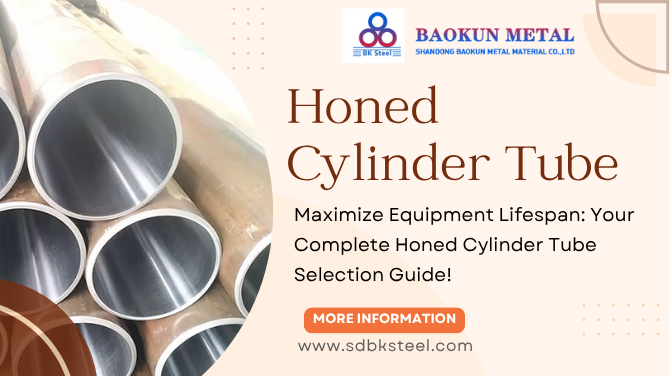Notifications

11 minutes, 11 seconds
-29 Views 0 Comments 0 Likes 0 Reviews

A hydraulic cylinder tube is a critical component in hydraulic systems, playing a central role in converting hydraulic energy into linear mechanical force and motion. These tubes form the body of hydraulic cylinders and provide a smooth, strong, and precisely machined chamber where the piston operates. Understanding the characteristics, types, materials, and manufacturing processes of hydraulic cylinder tubes is essential for engineers, technicians, and anyone involved in fluid power systems.
A hydraulic cylinder tube, also known as a honed tube or cylinder barrel, is a seamless or welded tube with a precisely finished internal surface. It acts as the housing for the piston and contains the hydraulic fluid under pressure. The internal surface must be highly smooth, durable, and resistant to wear and corrosion to ensure efficient operation and longevity of the hydraulic cylinder.
Materials Used
Hydraulic cylinder tubes are usually made from materials that can withstand high pressure and wear. The choice of material depends on the application's environment, required strength, machinability, and corrosion resistance.
Common materials:
Hydraulic cylinder tubes undergo precise manufacturing processes to achieve the desired strength, internal smoothness, and dimensional accuracy.
Common processes:
Applications
Hydraulic cylinder tubes are used in a wide array of industries and applications where hydraulic power is required:
Common applications include:
Choosing the right Hydraulic Cylinder Tube might seem straightforward, but in reality, it’s a technical process where mistakes can cost you not just time and money but also system efficiency and equipment lifespan.
Whether you're building high-performance hydraulic cylinders for heavy machinery, industrial presses, agricultural equipment, or marine systems, the quality and specifications of your hydraulic cylinder tube play a crucial role in determining the efficiency of your final product.
Yet, many engineers, procurement managers, and even seasoned manufacturers fall into the trap of selecting tubing based solely on price, availability, or general dimensions, without factoring in metallurgical properties, internal finishes, dimensional tolerances, or application-specific requirements.
At Shandong Baokun Metal Material Co., Ltd, we’ve worked with hundreds of customers across industries and regions, evaluating and correcting such costly errors. And over the years, one thing has become clear: Hydraulic cylinder failure is often not caused by poor sealing—it’s caused by poor tubing.
Hydraulic cylinders operate under high internal pressures, often in extreme conditions—whether it’s dust, humidity, corrosive fluids, or frequent load cycles. While the cylinder piston and seals do the dynamic work, the cylinder tube is the static backbone that holds up to intense pressure and structural fatigue.
A poorly selected or improperly honed hydraulic cylinder tube can result in:
On the flip side, choosing the correct material grade, surface finish, tolerance class, and wall thickness ensures enhanced hydraulic performance and long-term system reliability.
A hydraulic cylinder tube is a high-precision metal tube designed with an ultra-smooth bore surface to allow for seamless piston movement in hydraulic systems. These tubes are typically:
The most common standards used in production include DIN 2391, EN 10305-1/2, and ASTM A519, depending on the application and region.
The quality of the internal surface has a direct impact on seal performance, cylinder operating pressure, and durability under load cycles. Hence, precision is everything.
Challenges in Hydraulic Cylinder Tube Selection
As simple as tubes look on the outside, not all tubes are equal inside. Selecting the wrong type—or from the wrong supplier—can introduce several real-world challenges, such as:
Many buyers and engineers overlook these issues until it’s too late—only to discover that their imported hydraulic cylinder tube wasn’t honed properly, or didn’t meet the yield strength required for high-pressure applications.
Shandong Baokun: Your Trusted Source for Hydraulic Cylinder Tubes
At Shandong Baokun Metal Material Co., Ltd, we specialize in manufacturing and supplying high-performance hydraulic cylinder tubes that meet even the most demanding specifications.
We provide:
Additionally, our export services include full packaging, documentation (CO, MTC, inspection reports), and worldwide delivery support.
The hydraulic system is only as strong and reliable as its weakest component. In many cases, the hydraulic cylinder tube is that critical backbone, hidden inside the machine but vital to its operation.
By choosing the right material, finish, tolerance, and source, you can build stronger, safer, and longer-lasting hydraulic systems.
With decades of experience, Shandong Baokun Metal Material Co., Ltd assists engineering teams, cylinder manufacturers, and OEM specialists worldwide to source the right hydraulic cylinder tube with confidence.
1. What is the ideal surface finish for a hydraulic cylinder tube?
A Ra (roughness average) value of 0.2–0.4 µm is typically ideal, especially for applications involving dynamic seals. This level ensures reduced seal wear and higher system efficiency.
2. What tolerance class should I use for hydraulic tubing?
Most tubes used in hydraulic cylinders require H8 or H9 internal diameter tolerances to ensure excellent seal compatibility and piston operation balance.
3. Is seamless tubing better than welded for hydraulic applications?
Yes, seamless hydraulic cylinder tubes (especially cold-drawn) offer better strength, pressure resistance, and dimensional consistency compared to welded tubes, making them ideal for high-pressure hydraulic systems.
4. Can I customize the length and size of cylinder tubing?
Absolutely! At Shandong Baokun, we provide custom cut-to-length and custom OD/ID combinations to meet your exact project needs.
5. What is the difference between honed tubes and skived & roller burnished tubes?
Both are finishing processes for internal surfaces. Honing uses abrasive stones to create a fine surface, while skiving & roller burnishing mechanically remove material and compress surface peaks for a superior finish and dimensional control.
6. How do I verify the quality of hydraulic tubing before purchase?
Ask for documentation such as the Material Test Certificate (MTC), surface roughness reports, tolerance measurements, and testing data (pressure, UT, EC) from your supplier.
7. Do you export internationally?
Yes! Baokun exports to over 30 countries worldwide. We offer full support, including container loading, labeling, legal compliance, customs clearance, and logistics tracking.

